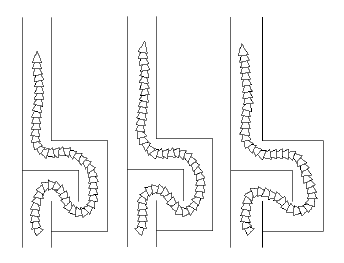
Abstract:
Robust behavioral control programs for a simulated 2d vehicle can be
constructed by artificial evolution. Corridor following serves here as
an example of a behavior to be obtained through evolution. A
controller's fitness is judged by its ability to steer its vehicle
along a collision free path through a simple corridor environment. The
controller's inputs are noisy range sensors and its output is a noisy
steering mechanism. Evolution determines the quantity and placement of
sensors. Noise in fitness tests discourages brittle strategies and
leads to the evolution of robust, noise-tolerant controllers. Genetic
Programming is used to model evolution, the controllers are
represented as deterministic computer programs.
Keywords: evolution of behavior, obstacle
avoidance, steering, genetic programming, genetic algorithms.
Citation:
Reynolds, C. W. (1994) Evolution of Corridor
Following Behavior in a Noisy World, in
From Animals to Animats 3: Proceedings of the Third
International Conference on Simulation of Adaptive Behavior (SAB94),
D. Cliff, P. Husbands, J-A Meyer, and S. Wilson, Editors, ISBN
0-262-53122-4, MIT Press, Cambridge, Massachusetts, pages 402-410.
Full article available online:
PDF (0.24 MB)
Postscript (compressed, 0.70 MB)